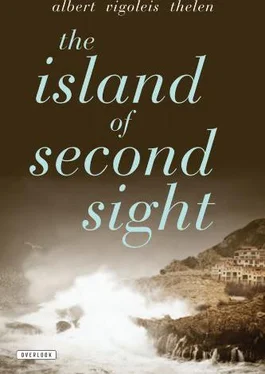I have a faulty memory. Printed matter doesn’t stay with me very long. After a single month I can re-read a poem or a novel that impressed me, and it’s as if I were seeing it for the first time. This forgetfulness of mine is no doubt an obstacle to critical penetration into a given work. But my preferred reading matter is the mystics, and it’s no accident that I am the translator of Pascoaes, the thinker who has brought the long line of Iberian mystics to its culmination. Still and all, despite the crevices and non-functional synapses in my brain, over time I knew the memoirs of Count Harry Kessler by heart. After a half-dozen retypings I had it down just like Goethe’s “Erl-King,” though with this difference: I learned Goethe’s classic spooky ballad in the final version approved by the author, whereas the Count’s recollections of peoples and fatherlands, having solidified in my brain to a kind of geode, were still very much in a state of flux. Although I can type pretty fast, I do it with two fingers only, and my eyes are always focused more on the keyboard than on the text. In this case, the result was that Kessler’s newest version kept slipping back to an old one. Ignoring his corrections, I re-inserted his erasures, sometimes leaving out whole words and phrases. Kessler called this a form of creative collaboration, for which he was grateful. The earlier version, he often said, was the better one. I was praised for what he deemed my sense of good style and my Wustmannian acuity.
Hearing this, I blushed crimson at my shameful, sieve-like memory, doubtless also in acknowledgment of the fact that it never functioned like a guard dog for my own writing activity. I refused to accept the borrowed plumes the Count was offering me, and begged him to pardon my wayward ways at the machine. Pardoning me, I said, should be doubly easy for him, seeing that he himself had warned me about the slavish work involved and that he had been a student of the psychologist Wilhelm Wundt, under whom he had earned his doctorate. From that time onward, Kessler often called me, in jest, his personal Wustmann. Our discussions of stylistic matters will remain in my mind as the most rewarding and instructive I have ever had. Thälmann was effectively repressed, and receded into the background. Professor Wilhelm Wundt would have had a ball with his electrical affect-sensing apparatus!
The first volume of Kessler’s memoirs came out in print, and with the proverbial courage of desperation I set to work typing out Volume Two, with the aid of my internal and external Wustmann. This new volume contained his accounts of the origins of the American aristocracy, including MacAllister’s famous “400.” He reported on his own lonely nights in Canadian cabins, where Kessler’s father owned a bear-hunting preserve as big as all of Bavaria, and on the naked girls in the upper-storey windows of bordellos in San Francisco — a lascivious custom that set the tone for other cities with the exception of Amsterdam, where vice gets displayed on the ground floor, although climate and Calvinist tradition prohibit a degree of undress worthy of the name. I of course applied my stylistic talents to the various versions of the manuscript. The Count later presented me with two copies of Times and Faces , one bound and the other in a cardboard cover, neither of them containing an inscription. He told me that he had pondered for a long while whether I would be willing to accept the “final edition” of his book, since I was no doubt thoroughly sick of it, and in light of the fact that three more volumes were yet to follow.
With the church reformer Johannes Kessler of St. Gall in mind, Beatrice baked some St. Gall Biber to celebrate the publication of the Part I of the Count’s memoirs. Beatrice now habitually spoiled Kessler with pastries and French conversation. Kessler, who suffered from homesickness, waxed sentimental and inscribed two dedications, one in gothic script, the other in roman. The gothic one was for his private Wustmann, his technical assistant in the production of the book. The other inscription was for Beatrice, who, tenacious as she is on all such occasions, insisted that he write one expressly in her name. But behold, the great diplomat and chronicler of peoples and fatherlands made a slip of the pen: Thälmann made a sudden reappearance, flowing from the Count’s pen with the radical-leftist’s proper name. When he noticed what he had done, Kessler was mortified. I burst out laughing. Beatrice, now caught unawares with her superstitions, turned pale and murmured something about evil omens. But because no events in this world can have so many bad outcomes as Beatrice is wont to predict for them, I was unfazed. Nonetheless, Count Kessler was upset, and took his leave soon after our little celebration, a feast that our Portuguese friends with their penchant for self-deprecation would call a copo d’agua —which is what it almost amounted to. Hardly had he left when Beatrice grabbed the book and disappeared into the kitchen. Years later, when we got to talking about this remarkable name-switching, I told her that instead of burning the entire book she at least ought to have salvaged the page containing the dedication. But apparently evil magic must be destroyed down to the last trace. Worse still, our other copy of Times and Faces got lost with other important and irreplaceable items during our escape from the island, whereas I took with us in our paltry bundle of possessions, of all things, the politically coordinated Wustmann. Well, as they say: books have their fate, although they have an easier time of it than the people who write them.
You can read in Kessler’s memoirs that his family came from the region of Lake Constance, near St. Gall. The first mention of a “Kessiler” occurs in a document from the year 1282. This man had an estate in Stodon, between Feldle and Vonwil. An ancestor of our Count named Heinrich Kessler got involved in one of the many conflicts of the period and was killed in a 1372 battle, as a miles in the army of the Imperial Cities — not a terribly distinguished occurrence. It wasn’t until the fourteenth century that the family, situated in and near St. Gall, began to flourish. His forefather Johannes Kessler was born in 1502, a religious reformer who did battle against the dreaded aristocratic abbot of the St. Gall Benedictine Monastery. The chronicles of the city of St. Gall shower praise on this gentleman’s broad education, his refined taste, his simple, gentle, noble, and amiable character, and his exemplary life. Kessler quotes this passage verbatim. This ancestor of his wrote a set of memoirs with the title Sabbata , in which (I’m following Kessler) he recounts how, on his journey as a young student to the university in Würzburg, he met Martin Luther at the Black Bear Inn in Jena, when Luther was staying incognito in the nearby Wartburg under the alias “Sir George”. Gustav Freytag retells this story in his novel Scenes from Old Germany .
For my novel about the Hun-less Tombs of the Huns, I had myself done a certain amount of research into my ur-Teutonic forebears on the banks of the Niers. It wasn’t easy to find the pertinent material, since I was able to consult only private libraries. Somewhere — I think it was in Don Juan’s highly erudite bookcases — I found a copy of Freytag’s Scenes in German, and it proved very useful indeed. By sheer coincidence, I read in it the account of the St. Gall reformer Johannes Kessler, and this happened in the days when that man’s great-great-grandson was wending his way to General Barceló Street. I had never heard of this harmless religious radical who played no role in the bloody 16th century battles of the theologians. To call him a “religious gangster,” as I did under the sweltering Unkulunkulu, was worse than slander. The pious fellow, who scrambled his way up from lowliest beginnings as a saddler’s apprentice to a career as a distinguished clergyman, didn’t deserve such an affront.
Читать дальше












